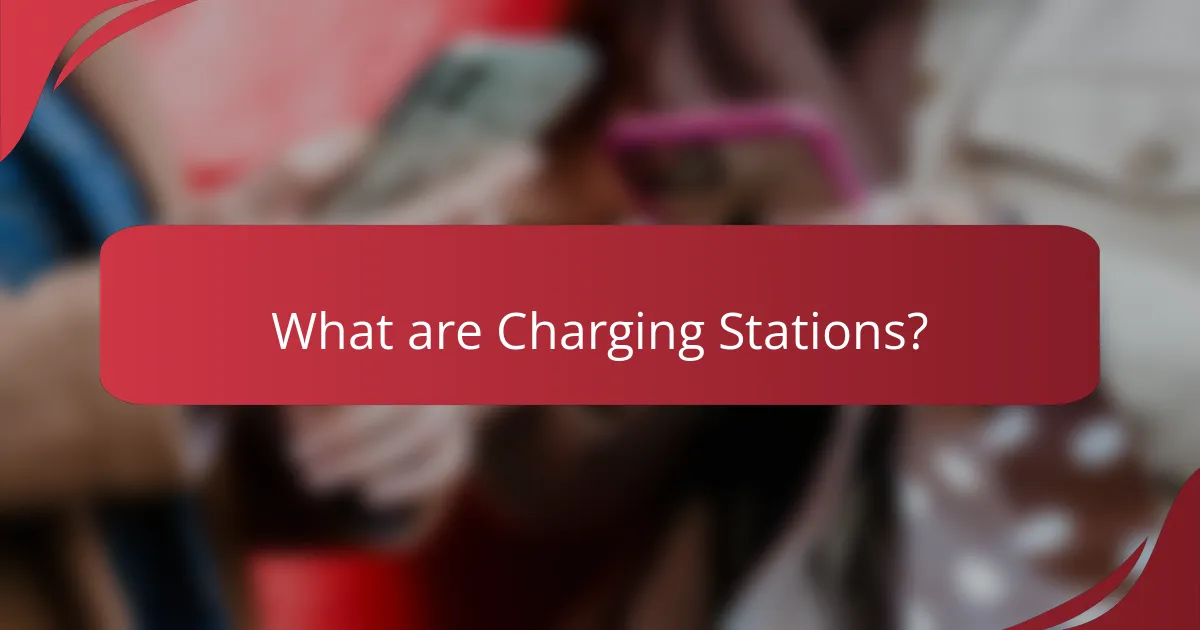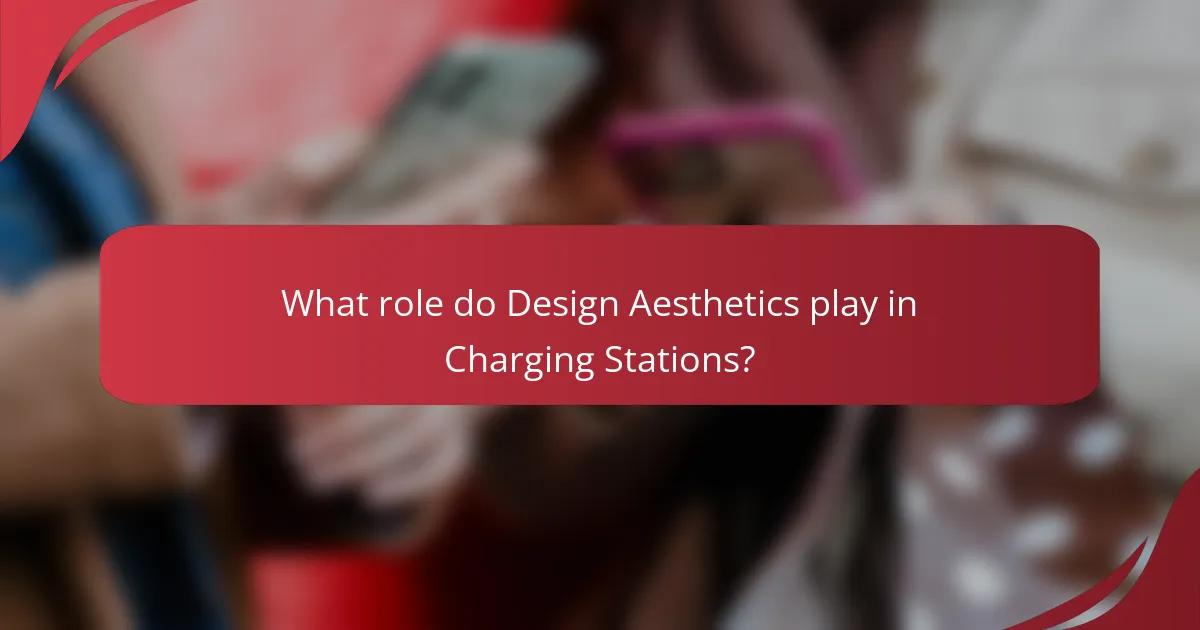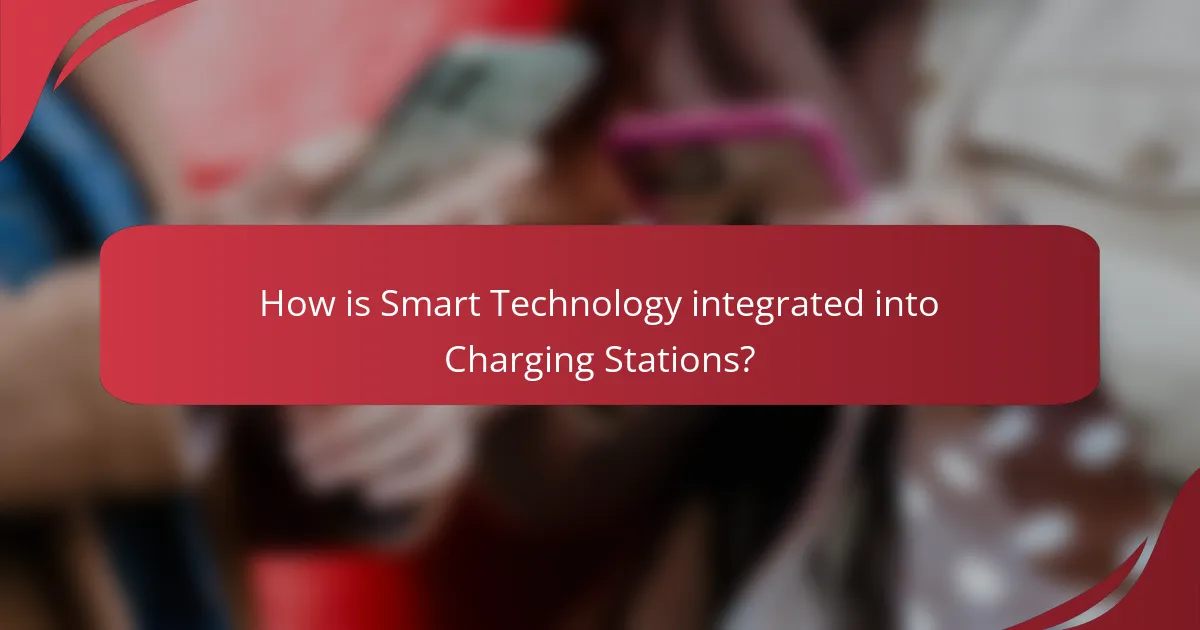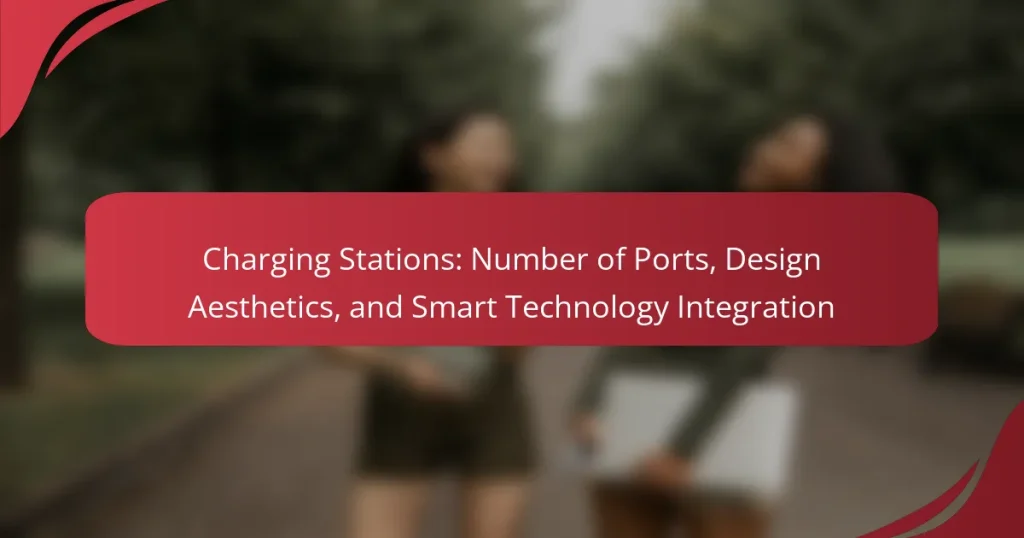Charging stations are facilities that provide electrical power to charge electric vehicles (EVs), playing a vital role in the infrastructure supporting the increasing number of EVs on the road. This article examines key aspects of charging stations, including the significance of the number of ports, which affects user convenience and efficiency; the impact of design aesthetics on user engagement and satisfaction; and the integration of smart technology that enhances functionality through features like app connectivity and real-time monitoring. By analyzing these elements, the article highlights how they contribute to the effectiveness and acceptance of charging stations in public spaces.

What are Charging Stations?
Charging stations are facilities designed to provide electrical power to charge electric vehicles (EVs). They serve as essential infrastructure for the growing number of EVs on the road. Charging stations can vary in design, capacity, and technology. Common types include Level 1, Level 2, and DC fast chargers. Level 1 chargers typically use standard household outlets, while Level 2 chargers require specialized equipment for faster charging. DC fast chargers are designed for rapid charging, significantly reducing the time needed to recharge an EV. According to the U.S. Department of Energy, there were over 100,000 public charging stations across the United States as of 2021. This growth reflects the increasing adoption of electric vehicles and the need for accessible charging options.
How do Charging Stations function?
Charging stations function by supplying electrical energy to electric vehicles (EVs) through a connector. They convert alternating current (AC) from the grid into direct current (DC) for fast charging. The station communicates with the vehicle to determine the appropriate charging rate. This ensures safe and efficient energy transfer. Charging stations can have multiple ports to serve several vehicles simultaneously. Smart technology integration allows for remote monitoring and management of charging sessions. Data from these stations can be used to optimize energy usage and improve user experience.
What are the main components of a Charging Station?
The main components of a charging station include the power supply, charging ports, and communication system. The power supply converts electrical energy for charging. Charging ports allow connection between the device and the power source. The communication system enables interaction between the charging station and the device, often for data transfer. Additional components may include safety features, user interface, and networking capabilities. These elements work together to provide efficient charging solutions for various devices.
How do different components influence charging speed?
Charging speed is influenced by several components, including the charger, cable, and device compatibility. The charger determines the maximum power output, often measured in watts. A higher wattage charger can deliver power more quickly. The cable also plays a critical role; its quality and specifications affect how much power can be transmitted. For instance, USB-C cables can support higher speeds than older USB types. Device compatibility is essential as well; a device must support fast charging protocols to benefit from increased speeds. Additionally, the battery’s chemistry and capacity can influence how quickly it can accept a charge. In summary, the interplay between the charger, cable, and device specifications collectively dictates the charging speed.
What types of Charging Stations are available?
There are several types of charging stations available. These include Level 1 charging stations, which use a standard 120-volt outlet. Level 2 charging stations operate on 240 volts and provide faster charging. DC fast charging stations deliver rapid charging capabilities, often found in commercial settings. Wireless charging stations offer a cable-free solution for electric vehicles. Additionally, there are solar-powered charging stations that harness renewable energy. Each type serves specific needs based on charging speed and location.
What are the differences between residential and commercial Charging Stations?
Residential charging stations are designed for home use, while commercial charging stations are intended for public or business settings. Residential stations typically have lower power output, often around 3.7 kW to 7.2 kW. This allows for overnight charging of electric vehicles. In contrast, commercial stations usually offer higher power outputs, ranging from 22 kW to 350 kW. This enables faster charging for multiple vehicles in a short time.
Residential charging stations are often single-port units. Commercial stations frequently have multiple ports to accommodate several vehicles simultaneously. The design aesthetics of residential stations tend to be more compact and integrated into home environments. Commercial stations may have larger, more robust designs to withstand frequent use.
Smart technology integration varies between the two. Residential stations may offer basic features like scheduling and remote monitoring. Commercial stations often include advanced functionalities such as payment processing, real-time usage analytics, and network connectivity. These differences cater to the distinct needs of individual users versus businesses or public infrastructures.
How do public Charging Stations vary in design and functionality?
Public charging stations vary in design and functionality primarily based on their number of ports, charging speed, and user interface. Some stations feature multiple ports to accommodate several vehicles simultaneously. Others may have a single port designed for fast charging, delivering higher power output.
Design aesthetics can also differ; some stations have sleek, modern designs to blend with urban environments, while others prioritize durability and weather resistance. User interfaces vary, with some stations offering touchscreen displays for easy navigation and payment options.
Additionally, smart technology integration is becoming common. Many stations now include features like real-time availability updates and mobile app connectivity. These variations cater to different user needs and enhance the overall charging experience.

How does the Number of Ports impact Charging Stations?
The number of ports directly impacts the functionality and efficiency of charging stations. More ports allow simultaneous charging of multiple devices. This increases user convenience and reduces wait times. Charging stations with fewer ports can lead to congestion and longer waiting periods. For example, a station with four ports can serve four users at once, while a two-port station can only serve two. Additionally, stations with more ports can cater to higher traffic areas, such as shopping centers or airports. This adaptability can enhance user satisfaction and encourage more frequent use. Thus, the number of ports is a crucial factor in the overall effectiveness of charging stations.
Why is the number of ports important in Charging Stations?
The number of ports in charging stations is crucial for accommodating multiple devices simultaneously. More ports allow for greater accessibility, reducing wait times for users. This is especially important in high-traffic areas where demand is high. Additionally, having multiple ports can enhance the utility of the station, serving more users at once. Research shows that stations with more ports can increase user satisfaction and encourage the use of electric vehicles. In urban environments, this can lead to a more efficient charging infrastructure. Thus, the number of ports directly influences the effectiveness and user experience of charging stations.
What are the typical configurations for Charging Station ports?
Typical configurations for charging station ports include Level 1, Level 2, and DC fast charging options. Level 1 ports usually use a standard 120V outlet. They are suitable for residential charging but offer slow charging speeds. Level 2 ports operate at 240V, providing faster charging for both residential and commercial use. DC fast charging ports can deliver high power levels, allowing for rapid charging in public stations. These configurations accommodate various electric vehicle models and charging needs. The choice of configuration affects charging time and location suitability.
How does the number of ports affect user experience?
The number of ports directly impacts user experience by enhancing convenience and accessibility. More ports allow multiple devices to charge simultaneously. This reduces wait times for users needing to power their devices. A higher number of ports can accommodate various device types, catering to diverse user needs. For example, charging stations with four or more ports can serve families or groups effectively. Additionally, charging stations with more ports often feature faster charging technologies, improving efficiency. According to a study by the International Journal of Energy Research, multi-port chargers can increase user satisfaction by 30% due to reduced charging times. Thus, the number of ports significantly influences user experience in charging stations.
What are the challenges associated with multiple ports?
Multiple ports in charging stations present several challenges. One significant challenge is the increased complexity of managing power distribution. More ports can lead to uneven power allocation among devices. This can result in slower charging speeds for some devices. Additionally, multiple ports require more space, impacting design aesthetics. Maintenance becomes more complicated with more ports, leading to higher operational costs. Furthermore, user confusion can arise from multiple port types and configurations. Lastly, compatibility issues may occur with different charging standards. These factors collectively complicate the implementation of multiple port charging solutions.
How do different port types affect compatibility?
Different port types significantly affect compatibility among devices. Each port type, such as USB-A, USB-C, and Lightning, has distinct physical and electrical characteristics. For example, USB-C supports faster data transfer and higher power delivery compared to USB-A. Devices designed for specific port types may not function properly with incompatible ports. A USB-C charger cannot directly power a device with only a USB-A port without an adapter. Additionally, the protocols supported by different ports can limit functionality. For instance, some USB-C ports support video output while others do not. Compatibility issues can lead to slower charging or complete failure to connect. Thus, understanding port types is crucial for ensuring device interoperability.
What solutions exist to manage multiple users at Charging Stations?
Solutions to manage multiple users at charging stations include reservation systems, user authentication, and load management. Reservation systems allow users to book charging slots in advance. This reduces wait times and ensures availability. User authentication systems require users to log in, allowing for better tracking of usage. Load management systems balance the power supply among multiple chargers. This prevents overload and optimizes energy distribution. Additionally, some stations implement mobile apps for real-time updates and notifications. These apps enhance user experience by providing information on charger availability and status.

What role do Design Aesthetics play in Charging Stations?
Design aesthetics play a crucial role in charging stations by influencing user experience and engagement. A visually appealing design can attract users and encourage them to utilize the station. Effective aesthetics can enhance brand identity and convey a message of innovation and reliability. Research indicates that well-designed charging stations can improve user satisfaction and promote positive perceptions of the technology. A study from the Journal of Urban Technology found that aesthetically pleasing public infrastructure increases usage rates by up to 30%. Overall, design aesthetics significantly impact the functionality and acceptance of charging stations in public spaces.
How does the design of a Charging Station influence its usage?
The design of a charging station significantly influences its usage by affecting user accessibility and overall functionality. A well-designed charging station with multiple ports accommodates more users simultaneously, enhancing convenience. User-friendly interfaces, such as clear labeling and intuitive layouts, promote efficient operation. Aesthetically pleasing designs can attract more users, as they create a positive first impression. Additionally, the integration of smart technology allows for real-time monitoring of charging status, optimizing the user experience. Research shows that stations with ergonomic design reduce waiting times and improve user satisfaction. Overall, thoughtful design elements directly correlate to increased usage rates and user engagement.
What are the key design elements that attract users?
Key design elements that attract users include functionality, aesthetics, and user experience. Functionality encompasses the number of ports available for charging. Stations with multiple ports cater to the needs of users who require simultaneous charging for multiple devices. Aesthetics refer to the visual appeal of the charging station. Sleek, modern designs often enhance user attraction. User experience involves ease of use and accessibility. Stations that are intuitive and user-friendly encourage positive interactions. According to a study by Nielsen Norman Group, design elements significantly influence user satisfaction and engagement.
How can aesthetics enhance the visibility of Charging Stations?
Aesthetics can enhance the visibility of charging stations by making them more visually appealing and recognizable. Attractive designs can draw attention and encourage usage. Use of bright colors and unique shapes can differentiate charging stations from other infrastructure. Strategic placement in high-traffic areas increases their visibility. Incorporating branding elements can create a strong identity for the charging stations. Research shows that well-designed stations can lead to increased user engagement. A study by the Electric Vehicle Infrastructure Project found that aesthetic appeal significantly influences user preferences. Thus, aesthetics play a crucial role in promoting charging station visibility and usage.
What are the trends in Charging Station design?
Trends in charging station design include modularity, aesthetic integration, and smart technology. Modularity allows for customizable configurations to accommodate various vehicle types. Aesthetic integration focuses on blending charging stations into urban environments. This trend enhances visual appeal while promoting sustainability. Smart technology integration enables features like real-time monitoring and user-friendly interfaces. These advancements improve user experience and operational efficiency. Research indicates that stations with appealing designs attract more users, leading to increased adoption of electric vehicles.
How are eco-friendly materials being integrated into Charging Station designs?
Eco-friendly materials are being integrated into charging station designs through the use of sustainable components. Manufacturers are utilizing recycled plastics and metals in their constructions. These materials reduce waste and lower carbon footprints during production. Additionally, solar panels are often incorporated to harness renewable energy. Bamboo and other fast-growing plants are also being used for aesthetic elements. This shift aligns with the growing demand for sustainable infrastructure. Research indicates that eco-friendly designs can enhance user experience and promote environmental responsibility. Studies show that consumers prefer charging stations made from sustainable materials, which can increase usage rates.
What innovative designs are emerging in the market?
Innovative designs in charging stations are focusing on modularity, aesthetic appeal, and smart technology integration. Modular designs allow users to customize the number of ports based on their needs. This flexibility caters to both personal and commercial environments. Aesthetic improvements include sleek, minimalist designs that blend with modern decor. Smart technology integration enables features like app-controlled charging and energy monitoring. These advancements enhance user experience and efficiency. According to a 2023 market report, 60% of consumers prefer charging stations with integrated smart features. This trend reflects a growing demand for convenience and functionality in charging solutions.

How is Smart Technology integrated into Charging Stations?
Smart technology is integrated into charging stations through features like app connectivity, real-time monitoring, and automated payment systems. These features allow users to locate available charging stations via mobile applications. Real-time monitoring provides updates on charging status and energy consumption. Automated payment systems enable seamless transactions without physical interaction. Additionally, some charging stations utilize smart grid technology to optimize energy distribution. This integration enhances user convenience and maximizes efficiency. According to a report by the International Energy Agency, smart charging solutions can significantly reduce grid stress during peak usage times.
What are the benefits of Smart Technology in Charging Stations?
Smart technology in charging stations enhances efficiency and user experience. It enables real-time monitoring of charging status. This allows users to track their vehicle’s charge remotely. Smart technology can optimize energy usage, reducing costs for operators. It also integrates with renewable energy sources, promoting sustainability. Additionally, these systems can provide data analytics for better resource management. They improve accessibility through user-friendly interfaces and mobile applications. Smart technology facilitates secure payment options, streamlining the charging process.
How does Smart Technology improve charging efficiency?
Smart technology improves charging efficiency by optimizing power delivery and reducing energy waste. It uses algorithms to assess the battery’s state and adjust the charging speed accordingly. This ensures that devices receive the right amount of power at the right time. Smart chargers can communicate with devices to determine their specific charging needs. They can also monitor temperature and voltage levels to prevent overheating. By doing so, they enhance battery longevity and performance. According to a study by the International Energy Agency, smart chargers can reduce energy consumption by up to 30%. This demonstrates the significant impact of smart technology on charging efficiency.
What features do Smart Charging Stations typically include?
Smart Charging Stations typically include features such as multiple charging ports, user-friendly interfaces, and smart connectivity. These stations often support various charging standards, accommodating different electric vehicle models. They frequently offer real-time monitoring of charging status and energy consumption. Many smart stations integrate mobile app controls for remote access and scheduling. Some also include payment processing capabilities for convenience. Advanced stations may feature renewable energy integration, such as solar power. Enhanced security measures, like user authentication, are common to protect user data. Additionally, some stations provide diagnostic tools to monitor performance and maintenance needs.
What challenges are associated with Smart Technology integration?
Smart Technology integration faces several challenges. These include interoperability issues among different devices and platforms. Many smart devices do not communicate well with each other. Security vulnerabilities are also a significant concern. Cyberattacks on connected devices can lead to data breaches. High costs of implementation can deter businesses from adopting smart technology. Additionally, the complexity of installation and maintenance can pose problems. User resistance to adopting new technology often slows integration efforts. Finally, regulatory compliance can complicate the integration process.
How do security concerns affect the adoption of Smart Charging Stations?
Security concerns significantly hinder the adoption of Smart Charging Stations. These concerns include risks of data breaches and unauthorized access to user information. Vulnerabilities in the charging infrastructure can lead to cyberattacks. Such attacks may compromise the safety of electric vehicles and their users. Studies show that 60% of consumers are hesitant to use public charging stations due to security fears. The lack of standardized security protocols further exacerbates these apprehensions. As a result, manufacturers face pressure to enhance security features in their products. This focus on security is essential for building consumer trust and encouraging widespread adoption.
What are the potential costs of implementing Smart Technology?
The potential costs of implementing Smart Technology include initial setup expenses, ongoing maintenance, and potential software updates. Initial setup costs can range from thousands to millions of dollars depending on the scale. Ongoing maintenance can add an estimated 10-20% of initial costs annually. Software updates may incur additional fees, often requiring subscriptions or licenses. Research indicates that businesses might face unexpected costs if integration issues arise. These costs can escalate if extensive training for staff is necessary. Overall, the financial impact varies significantly based on the technology’s complexity and the organization’s size.
What best practices should be considered for using Charging Stations effectively?
To use charging stations effectively, prioritize location and accessibility. Choose charging stations that are conveniently located near high-traffic areas. Ensure that the charging ports are clearly marked and easy to access. Monitor the charging station’s availability in real-time through mobile apps or websites. This can help users plan their charging needs better. Implement a reservation system to reduce wait times during peak hours. Regular maintenance of charging stations is essential to ensure they function properly. According to the U.S. Department of Energy, well-maintained stations can improve user satisfaction and increase usage rates.
Charging stations are essential facilities providing electrical power to charge electric vehicles (EVs), with various types including Level 1, Level 2, and DC fast chargers. This article explores the impact of the number of ports on charging efficiency and user experience, the significance of design aesthetics in attracting users, and the integration of smart technology to enhance functionality. Key components, challenges, and trends in charging station design are also examined, alongside best practices for effective usage. Understanding these elements is crucial for optimizing the infrastructure supporting the growing adoption of electric vehicles.


